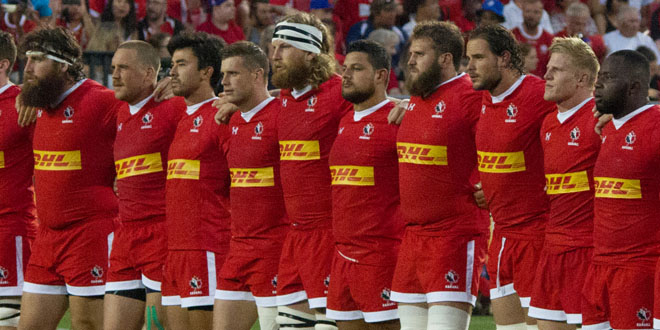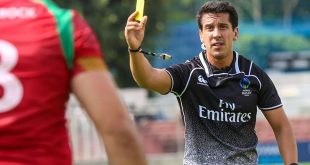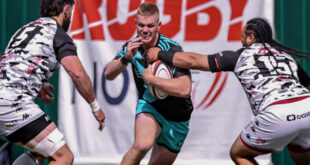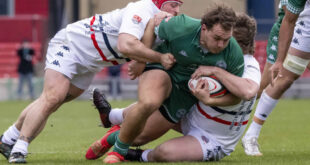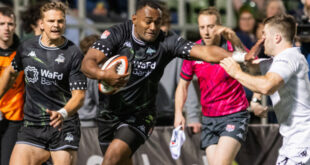As Canada move ever closer to their final World Cup selection, we take a closer look at where the squad stands, position by position, and who might be the unlucky four who don’t make the cut when head coach Kieran Crowley trims his squad from 35 to 31 at the end of August.
With the Pacific Nations Cup over and done, warm-up matches against the US Eagles in Ottawa on August 22 and Glasgow Warriors in Halifax on August 29 are all that remain for fringe players to put up their hands for a plane ticket to England and a spot in World Rugby’s flagship event.
PROP
Six props have been named in the training squad, and five will go to England. The incumbent World Cup duo is Hubert Buydens and Jason Marshall. A year ago there would have been no question that they would be reprising that role, but a year is a long time in rugby and all of a sudden Buydens looks a little long in the tooth and Marshall is struggling for fitness.
Djustice Sears-Duru is the new kid on the block and had a very impressive PNC, such that he might force Crowley’s hand despite his lack of big game experience. His power in the contact area is outstanding and he didn’t look any less competent in the scrum, though it would be a big decision to leave Buydens out at this stage. Tom Dolezel is another from Ontario who just missed the cut at the last World Cup, but has shown enough in the past year to suggest that he might be the best scrummager of the group at loosehead. He has also proven himself capable of playing both sides of the scrum, making him an ideal candidate for the 5th spot.
Tighthead is a real conundrum, with none of three remaining candidates inspiring immutable confidence. Doug Wooldridge was probably considered more a loosehead when he didn’t make the cut at the last World Cup, but has since proved himself the best option in the scrum on the right side. Andrew Tiedemann went to New Zealand as a youngster, and is now a full time professional. He’s a decent all around option who can also fill in at loosehead in a pinch. Jake Ilnicki’s exclusion was a bit of a surprise, evidently not doing enough against the Eagles to merit selection.
Crowley has a lot to consider here. Does he opt for the best scrum, the best carriers, or simply to preserve combinations? Assuming both Dolezel and Marshall are fit to be considered, the final squad decision will likely be between Dolezel and Tiedemann. The starting spots, on form, should be well up for grabs.
HOOKER
A problem position for Canada throughout the professional era, there doesn’t seem to be an easy answer here yet again. Based on the PNC, it’s hard to argue that Ray Barkwill doesn’t have the best case as first choice. His set piece overall is the best on offer, and while sometimes prone to moments of over-exuberance, at his best he is a charismatic and inspirational figure in the loose.
Former skipper Aaron Carpenter has had a very rough couple of weeks with his most productive moments coming as a substitute in his old back row position. Missing the majority of the club season with injury hasn’t helped him settle at the set piece and it’s fair to say he’s not quite where we expected him to be in that department.
Benoît Pifféro has had a decent amount of playing time at Blagnac this season and did reasonably well in both the Pacific Challenge and the PNC. His lineout work looks the best of the three, though he doesn’t offer as much in the tight spaces.
Unless Crowley decides that Tiedemann or Sears-Duru is a suitable option as a third string hooker – there has been nothing shown recently to suggest that – all three players will travel.
SECOND ROW
Jamie Cudmore and Jebb Sinclair formed the engine room in New Zealand and there’s a good chance they will be asked to do so again, despite both missing the PNC with injury. Cudmore at least is a certainty, and Sinclair can be expected to be found either at lock or blindside flank. They offer immense physical presence, though neither is a specialist lineout jumper.
The aerial battle has not been kind either during the PNC. Jon Phelan at 203cm (6’8”) is the tallest, but he is not a carrying option and tends to come out second best in the collisions. His Doncaster clubmate Tyler Hotson suffers from a lack of height, though he does offer experience having been part of the squad in 2011. Brett Beukeboom is of similar build and a willing ball runner, but is not dominant in either the lineout or the tackle.
Evan Olmstead is the newest cap and offers a good mix of size, lineout ability, and aggression in the loose. Going on PNC form he was the best lock on display and should be a certainty to head to England. For reasons unknown France-based Cameron Pierce has not been given a run, which seems an odd decision given his height and athleticism.
Sinclair covers both second and back row, so expect only one from Phelan, Hotson, and Beukeboom to travel, with the latter’s youth possibly in his favour. There is very little between the three so it will be a difficult decision for the selectors.
BACK ROW
Carpenter’s move to the front row and Sinclair most likely being considered at lock leaves Nanyak Dala as the only returning loose forward. He’s probably still short of full fitness as he battles an arm injury, but his inclusion is a vote of confidence that he’ll be close enough to top form come September. With Adam Kleeberger and Chauncey O’Toole both out of the reckoning he could be the top choice at openside.
Also competing for a spot on the flank will be John Moonlight, Richard Thorpe, and Kyle Gilmour. None are true openside specialists, and each have similar attributes in terms of being multi-skilled. Crowley could well opt for left and right flankers as opposed to the more conventional modern roles. Thorpe looked to have the best form in the PNC, with his professional experience in the English Premiership also supporting his claim.
Tyler Ardron is the captain and starting no8. He started slowly in the PNC, and was unfortunate to take a knock to the knee against Samoa as he looked motivated in the early minutes. There is a remote possibility that Crowley re-considers Carpenter in the back row with Ardron on the blindside, but that seems highly unlikely at this late stage.
All five of the above should be expected to travel, with the only questions surrounding who gets the first crack on the side of the scrum.
SCRUMHALF
Oddly enough it’s third-string halfback Jamie Mackenzie who is the sole returning player at scrumhalf from the last World Cup. Ed Fairhurst has since retired and Sean White did not make the grade this time around. Mackenzie looks likely to retain the same role in England.
Phil Mack has done well to return from a bad knee injury to put himself back in the frame. Though he will be turning 30 the day before Canada play Ireland, this will be his first World Cup, having been considered a sevens specialist only in the past. His ability to cause havoc around the breakdown is second to none, but his core skills in the full game are not as sharp and he can take unnecessary risks at times. He looks certain to be used as an impact sub.
The best bet as starting scrumhalf is Gordon McRorie, the Scottish-born Wolf Pack standout who now also set to be first choice goal kicker, with record points-scorer James Pritchard left out of squad completely. McRorie offers an accurate kicking game from hand and tee, and generally distributes well from the base. Hopefully come September he will be more familiar with both his teammates and the game plan, which until now hasn’t quite been tailored to his talents.
Three scrumhalves traveled to New Zealand and all three above should head to England.
FLYHALF
An even greater problem than hooker has been flyhalf, with nobody locked in since Ander Monro’s retirement in 2011. Nathan Hirayama traveled to New Zealand as his understudy but barely saw any game time and has started only three tests since, focusing more on his starring role with the sevens side. Hirayama showed his unquestionable footballing skills with some outstanding kicking off both feet against Samoa, but he remains a bit of a mystery man heading into the trip to England.
Liam Underwood looked to be the heir apparent to the shirt when he arrived on the scene in 2013, but concussion problems saw him sit out the entire 2014 season and he looked rusty in the PNC. Like Hirayama, his skills aren’t in question, it’s his lack of experience and confidence that are a slight worry. Crowley seems to favour his combination with McRorie, especially given Hirayama’s long standing connection with Mack, but it’s not set in stone and Hirayama’s performance against Samoa will give him food for thought.
Both are certainties for the final squad, with Harry Jones and Connor Braid offering alternatives options should they be required.
CENTRE
The midfield combinations have been a revolving door just as much in recent years, with a number of permutations tried and tested since 2011. Conor Trainor and Ciaran Hearn were both part of the team that traveled, but neither were used at centre, instead seeing action on the wing. That failure to specialise at a position, as well as a clear focus on sevens, has effected their performances and instead of two refined options we now have generally skilled players with alignment and decision making deficiencies.
DTH van der Merwe was one of the standout centres in pool play at the last World Cup and many concerned observers have raised eyebrows at Crowley’s confusing reluctance to play him in the no13 jersey since. While it’s true he plays the majority of his club rugby on the wing, he remains Canada’s best attacking option in the midfield by a wide margin, and with strong alternatives on the wing it seems most logical to move him back inside. It could be that Crowley has simply been ‘weighing his options’ during the PNC, so judgement is best reserved for the upcoming warm-up matches.
Inside centre looks a straight decision between Connor Braid and Nick Blevins. Braid has spent the season playing professional rugby and seems to have ideal skills for the position, with good passing and kicking skills from time spent playing flyhalf as well as a strong running game. Blevins is a traditional hard-running centre who has taken his chances well in the PNC, even showing a little more pace than usual.
One of the outside backs will not be making the trip, and of the five above Trainor looks most at risk, though form, fitness, and van der Merwe’s ultimate destination will affect that decision.
WING
If van der Merwe is moved to the midfield, it leaves World Cup veterans Phil Mackenzie and Taylor Paris to battle it out for the left wing spot, with Ospreys standout Jeff Hassler a certainty for the no14 shirt. Hassler’s development has been rapid since his debut in 2012 to the point where he is now one of the first names on the team sheet.
Mackenzie was the starter in 2011 and though he has seen his form dip in recent years, he has looked determined in his return to international rugby this season, showing well in both the Pacific Challenge and the PNC. He can also cover the midfield, but looks most at home as a slashing winger with good strength.
Paris was the baby of the side in New Zealand but has grown into a class player with Agen in France. His pace and finishing ability are worth a starting spot, and his defense continues to improve. If his groin injury is cleared up, he could form a potent wing duo with Hassler, with Mackenzie a versatile bench option, but the latter does not look willing to cede the starting role without a fight.
The safe bet is that all three will travel, but it depends on the fitness of Paris, and again where Crowley sees van der Merwe. There seems little debate that only two of Paris, Mackenzie, and Trainor will get a seat on the plane.
FULLBACK
As James Pritchard heads back to Bedford, it’s Matt Evans and Harry Jones who will go to England as the fullback options. For Evans this will be his second World Cup, and he is now a certainty to wear the no15 jersey after covering both wing and fullback in 2011.
The decision to field Jones at the back has cost Pritchard his spot, with Jones offering more versatility with his ability to cover flyhalf and the midfield as well. Some might wonder if Pritchard’s experience might have been more useful to have around the squad given that Jones is unlikely to be challenging for a starting jersey, but those are the tight calls that have to be made for the World Cup.
Of course there is an outside chance that it’s Jones who is left at home, with both Braid and Hearn having covered fullback in the past, but it seems most plausible that Jones will go as primary backup to Evans.
 Americas Rugby News Rugby news from across the Americas!
Americas Rugby News Rugby news from across the Americas!
